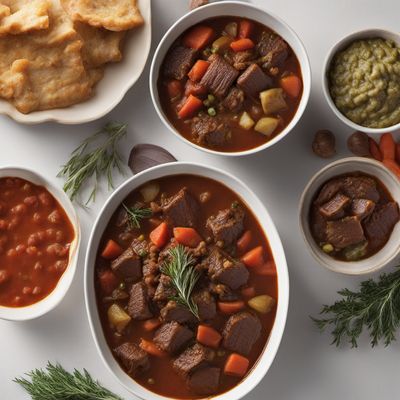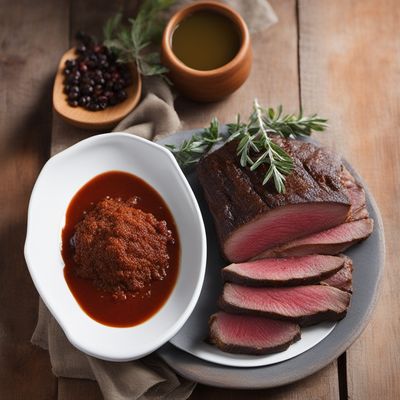
Ingredient
Buffalo fresh meat
The Lean and Flavorful Protein
Buffalo fresh meat comes from the American bison, a large mammal native to North America. It is known for its deep red color, fine marbling, and tender texture. The flavor of buffalo meat is often described as slightly sweeter and richer than beef, with a hint of gamey undertones. It is leaner than beef, making it a healthier choice for those looking to reduce their fat intake. Buffalo meat can be used in a wide range of recipes, including burgers, stews, roasts, and stir-fries.
Origins and history
Buffalo meat has a long history of consumption by Native American tribes, who relied on bison as a primary food source. With the colonization of North America, bison populations declined significantly due to overhunting. However, conservation efforts have helped revive bison populations, and today, buffalo meat is enjoyed by people around the world. It is commonly found in the United States and Canada, where bison ranching is prevalent.
Nutritional information
Buffalo meat is a nutrient-dense protein source that is lower in fat and calories compared to beef. It is rich in essential amino acids, iron, and vitamin B12. Buffalo meat is also a good source of omega-3 fatty acids, which are beneficial for heart health.
Allergens
Buffalo meat is not known to be allergenic, but individuals with sensitivities to red meat or specific proteins found in buffalo meat may experience adverse reactions.
How to select
When selecting buffalo fresh meat, look for cuts that are deep red in color, with fine marbling throughout the meat. The meat should be firm to the touch and have a fresh, slightly sweet aroma. Choose cuts that are well-trimmed and free from excessive fat or connective tissue.
Storage recommendations
To maintain the freshness and quality of buffalo fresh meat, store it in the refrigerator at or below 40°F (4°C). Keep the meat in its original packaging or wrap it tightly in plastic wrap or aluminum foil to prevent air exposure. Use the meat within a few days or freeze it for longer storage.
How to produce
Buffalo meat is typically produced on specialized bison ranches. Raising bison requires specific knowledge and infrastructure, including adequate grazing land and proper handling facilities. It is recommended to purchase buffalo meat from reputable suppliers or local farmers who follow sustainable and ethical practices.
Preparation tips
Buffalo meat can be prepared using various cooking methods, including grilling, roasting, braising, or stir-frying. Due to its leanness, buffalo meat cooks faster than beef and can become tough if overcooked. It is best to cook buffalo meat to medium-rare or medium doneness to retain its tenderness and juiciness. Marinating the meat before cooking can help enhance its flavor and tenderness.
Substitutions
Beef can be used as a substitute for buffalo meat, as they have similar characteristics and flavors. However, beef has a higher fat content compared to buffalo meat. Other suitable substitutes include venison or elk, although they may have slightly different flavors and textures.
Culinary uses
Buffalo fresh meat is commonly used in a variety of dishes, including burgers, meatballs, stews, chili, and steaks. It can be seasoned with various herbs, spices, and marinades to enhance its flavor. Buffalo meat pairs well with ingredients such as garlic, rosemary, thyme, mushrooms, and red wine.
Availability
Buffalo meat is commonly available in the United States and Canada, where bison ranching is prevalent. It can also be found in select specialty meat stores or online retailers.
More ingredients from this category
Recipes using Buffalo fresh meat » Browse all

Rocky Mountain Cabbage Roll
Savory Stuffed Cabbage Delight

North Dakota-style Tutmaç Soup
Hearty Prairie Noodle Soup: A Taste of North Dakota

North Dakota Bison Stew
Savory Bison Stew with North Dakota Flair

Native American Bison Steak
Sacred Bison Steak: A Native American Delight

Haute Cuisine Pizza Margherita
Elevated Margherita: A Haute Twist on a Classic Italian Pizza

North Dakota Bison Stew
Prairie Bison Delight

Rocky Mountain Grilled Bison Skewers
Smokey Bison Delight: Grilled Skewers with a Rocky Mountain Twist

Rocky Mountain Slow-Cooked Bison Soup
Mountain Bison Delight: A Hearty Slow-Cooked Soup from the Rockies

North Dakota Bison Pepper Steak
Savory Bison Pepper Steak with a North Dakota Twist

Rocky Mountain Bison Pizza
Savory Bison Delight: Rocky Mountain Bison Pizza

North Dakota Bison Stew
Prairie Bison Delight

Sarajevska Čorba with a Native American Twist
Hearty Bison Stew with Traditional Native American Flavors
